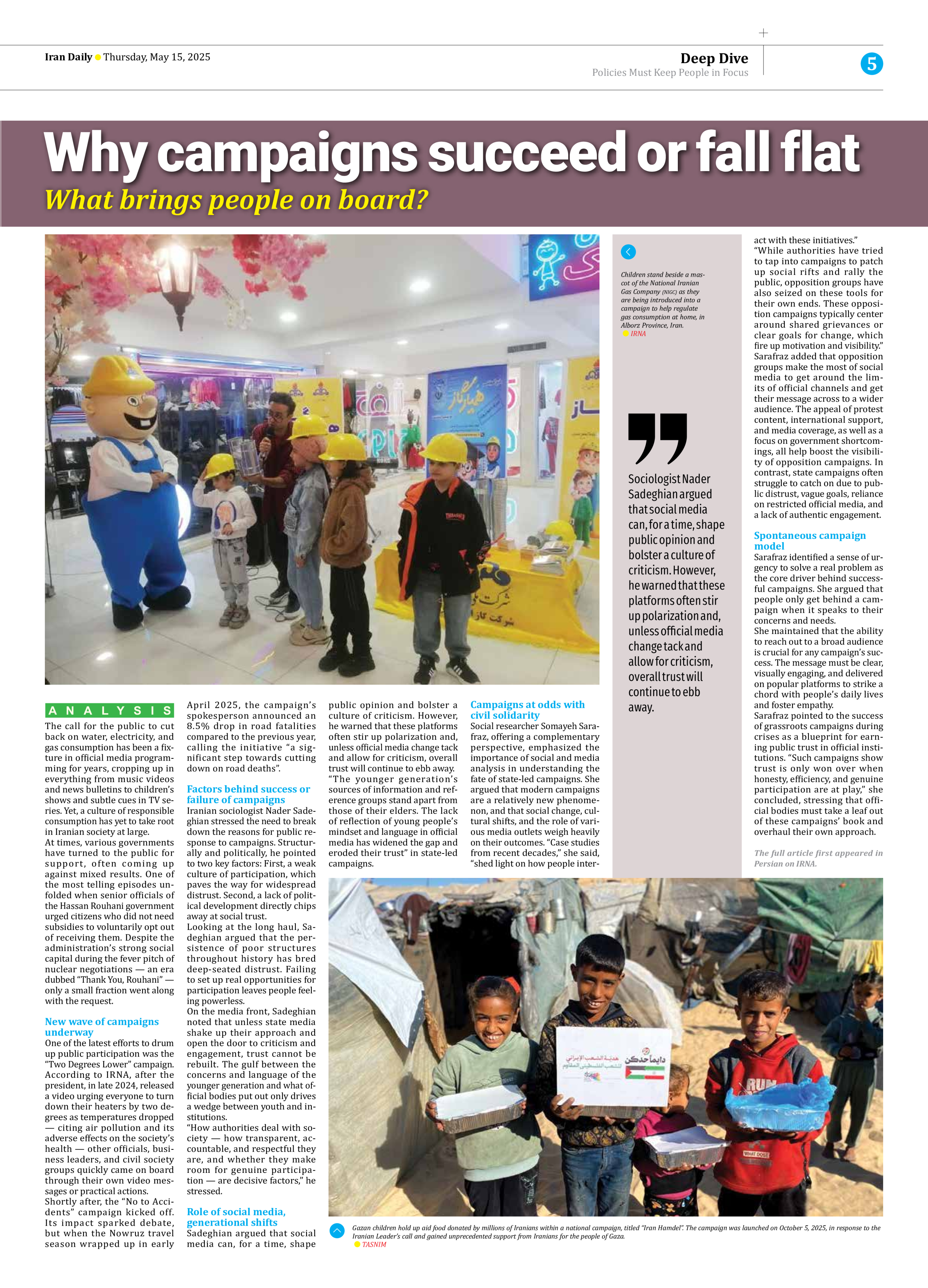
Why campaigns succeed or fall flat
What brings people on board?
The call for the public to cut back on water, electricity, and gas consumption has been a fixture in official media programming for years, cropping up in everything from music videos and news bulletins to children’s shows and subtle cues in TV series. Yet, a culture of responsible consumption has yet to take root in Iranian society at large.
At times, various governments have turned to the public for support, often coming up against mixed results. One of the most telling episodes unfolded when senior officials of the Hassan Rouhani government urged citizens who did not need subsidies to voluntarily opt out of receiving them. Despite the administration’s strong social capital during the fever pitch of nuclear negotiations — an era dubbed “Thank You, Rouhani” — only a small fraction went along with the request.
New wave of campaigns underway
One of the latest efforts to drum up public participation was the “Two Degrees Lower” campaign. According to IRNA, after the president, in late 2024, released a video urging everyone to turn down their heaters by two degrees as temperatures dropped — citing air pollution and its adverse effects on the society’s health — other officials, business leaders, and civil society groups quickly came on board through their own video messages or practical actions.
Shortly after, the “No to Accidents” campaign kicked off. Its impact sparked debate, but when the Nowruz travel season wrapped up in early April 2025, the campaign’s spokesperson announced an 8.5% drop in road fatalities compared to the previous year, calling the initiative “a significant step towards cutting down on road deaths”.
Factors behind success or failure of campaigns
Iranian sociologist Nader Sadeghian stressed the need to break down the reasons for public response to campaigns. Structurally and politically, he pointed to two key factors: First, a weak culture of participation, which paves the way for widespread distrust. Second, a lack of political development directly chips away at social trust.
Looking at the long haul, Sadeghian argued that the persistence of poor structures throughout history has bred deep-seated distrust. Failing to set up real opportunities for participation leaves people feeling powerless.
On the media front, Sadeghian noted that unless state media shake up their approach and open the door to criticism and engagement, trust cannot be rebuilt. The gulf between the concerns and language of the younger generation and what official bodies put out only drives a wedge between youth and institutions.
“How authorities deal with society — how transparent, accountable, and respectful they are, and whether they make room for genuine participation — are decisive factors,” he stressed.
Role of social media, generational shifts
Sadeghian argued that social media can, for a time, shape public opinion and bolster a culture of criticism. However, he warned that these platforms often stir up polarization and, unless official media change tack and allow for criticism, overall trust will continue to ebb away.
“The younger generation’s sources of information and reference groups stand apart from those of their elders. The lack of reflection of young people’s mindset and language in official media has widened the gap and eroded their trust” in state-led campaigns.
Campaigns at odds with civil solidarity
Social researcher Somayeh Sarafraz, offering a complementary perspective, emphasized the importance of social and media analysis in understanding the fate of state-led campaigns. She argued that modern campaigns are a relatively new phenomenon, and that social change, cultural shifts, and the role of various media outlets weigh heavily on their outcomes. “Case studies from recent decades,” she said, “shed light on how people interact with these initiatives.”
“While authorities have tried to tap into campaigns to patch up social rifts and rally the public, opposition groups have also seized on these tools for their own ends. These opposition campaigns typically center around shared grievances or clear goals for change, which fire up motivation and visibility.”
Sarafraz added that opposition groups make the most of social media to get around the limits of official channels and get their message across to a wider audience. The appeal of protest content, international support, and media coverage, as well as a focus on government shortcomings, all help boost the visibility of opposition campaigns. In contrast, state campaigns often struggle to catch on due to public distrust, vague goals, reliance on restricted official media, and a lack of authentic engagement.
Spontaneous campaign model
Sarafraz identified a sense of urgency to solve a real problem as the core driver behind successful campaigns. She argued that people only get behind a campaign when it speaks to their concerns and needs.
She maintained that the ability to reach out to a broad audience is crucial for any campaign’s success. The message must be clear, visually engaging, and delivered on popular platforms to strike a chord with people’s daily lives and foster empathy.
Sarafraz pointed to the success of grassroots campaigns during crises as a blueprint for earning public trust in official institutions. “Such campaigns show trust is only won over when honesty, efficiency, and genuine participation are at play,” she concluded, stressing that official bodies must take a leaf out of these campaigns’ book and overhaul their own approach.
The full article first appeared in Persian on IRNA.







